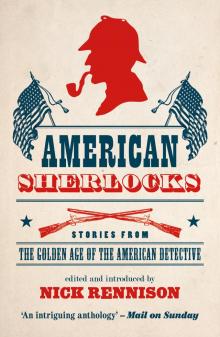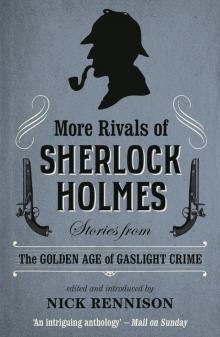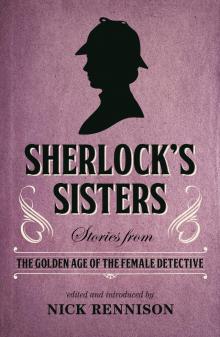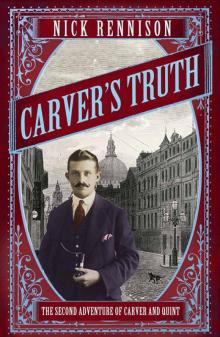- Home
- Nick Rennison
American Sherlocks
American Sherlocks Read online
PRAISE FOR NICK RENNISON’S ANTHOLOGIES
‘An intriguing anthology’ – Mail on Sunday
‘These 15 sanguinary spine-tinglers… deliver delicious chills’ – Christopher Hirst, Independent
‘A book which will delight fans of crime fiction’ – Verbal Magazine
‘It’s good to see that Mr Rennison has also selected some rarer pieces – and rarer detectives, such as November Joe, Sebastian Zambra, Cecil Thorold and Lois Cayley’ – Roger Johnson, The District Messenger (Newsletter of the Sherlock Holmes Society of London)
‘A gloriously Gothic collection of heroes fighting against maidens with bone-white skin, glittering eyes and bloodthirsty intentions’ – Lizzie Hayes, Promoting Crime Fiction
‘Nick Rennison’s The Rivals of Dracula shows that many Victorian and Edwardian novelists tried their hand at this staple of Gothic horror’ – Andrew Taylor, Spectator
‘The Rivals of Dracula is a fantastic collection of classic tales to chill the blood and tingle the spine. Grab a copy and curl up somewhere cosy for a night in’ – Citizen Homme Magazine
INTRODUCTION
We all have a picture in our minds of the archetypal detective of American fiction. The hardboiled, wisecracking private eye, walking a city’s mean streets. Dashiell Hammett’s Sam Spade, Raymond Chandler’s Philip Marlowe or one of the hundreds, probably thousands, of other gumshoes who have trodden in their footsteps. But that style of detective only came into being in the late 1920s and early 1930s, most influentially in Hammett’s novels and in the pages of the legendary magazine Black Mask. American crime fiction has a much longer history.
It really begins with Edgar Allan Poe. (The history of most genre fiction in the USA really begins with Edgar Allan Poe.) Claims for precedence have been made on behalf of earlier works such as Charles Brockden Brown’s 1799 novel Edgar Huntly and some of Nathaniel Hawthorne’s shorter fiction. However, it was Poe who established many of the tropes of crime fiction which are still being used by writers today. In three short stories published in the 1840s – ‘The Murders in the Rue Morgue’, ‘The Mystery of Marie Rogêt’ and ‘The Purloined Letter’ – he created the templates for much of what was to come. The locked-room mystery; the story based on a true crime; the clues, sometimes hidden in plain sight, which point towards a satisfying explanation of what initially seems inexplicable; the bumbling police outshone by the brilliant amateur. All of these derive ultimately from what Poe himself called his ‘tales of ratiocination’. His character C Auguste Dupin is the archetype of the detective hero with superior powers of deduction and his influence on later creations, most notably Sherlock Holmes, is clear.
Yet Poe’s impact was not markedly felt in his own country in the decades immediately following his death in 1849. There are stories and novels from the 1850s and 1860s which can be classed retrospectively as crime fiction. The Dead Letter of 1866 by Seeley Regester (the pseudonym of the woman writer Metta Victoria Fuller Victor), for instance, is the story of the narrator’s quest to track down a murderer. Another female author, Harriet Spofford, created what was arguably one of the first ‘series’ detectives in history in Mr Furbush who appeared in several stories published in Harper’s New Monthly Magazine. However, the genre Poe had pioneered did not gain much more than a toehold in the traditional publishing houses and magazines of the American literary world.
It was in the more downmarket arena of the so-called ‘dime novel’ that the figure of the detective finally emerged from the wings and, often enough, took centre stage. The equivalent of the British ‘penny dreadful’, the dime novel began to flourish in the 1860s. The first example of the genre is usually said to be Malaeska, the Indian Wife of the Great Hunter, written by a prolific author and editor, Ann S Stephens, and published by the firm of Beadle & Adams in 1860. Thousands of titles followed in the last decades of the nineteenth century and the opening ones of the twentieth. Several factors fuelled this explosion in cheap genre fiction. Literacy levels began to increase around the time of the American Civil War and continued to do so in the years between 1870 and 1900. At the same time, new printing technologies meant that publishers could issue more books at cheaper prices.
As the title of Ann Stephens’s original dime novel indicates, tales of Native Americans and what was increasingly becoming known as the ‘Wild West’ were popular. The army scout and bison hunter William Cody was transformed into the national hero ‘Buffalo Bill’ by the adventures attributed to him in stories by writers such as Ned Buntline and Prentiss Ingraham. Other genres thrived as well. One of these was the detective novel. Characters like ‘Old Sleuth’, ‘Lady Kate, the Dashing Female Detective’, ‘Sam Strong the Cowboy Detective’ and ‘Old King Brady’ battled bad guys in stories that made up in lively action for what they lacked in literary sophistication. However, the major detective to emerge from the dime novel was Nick Carter.
After his first appearance in the New York Weekly in 1886, Carter soon graduated to his own series, the Nick Carter Weekly. A square-jawed, two-fisted, all-American hero, Carter proved to be a character of astonishing longevity. Transformed into a kind of sub-James Bond figure, he appeared in dozens of cheap paperbacks in the 1960s and new stories about him were still appearing in the early 1990s. In his earliest incarnations, he was kept busy righting wrongs across America and around the world in a series of breath-taking and occasionally fantastical adventures. He gathered about him a small platoon of willing assistants and faced a rogues’ gallery of memorable opponents, including the supervillain Doctor Quartz, Dazaar the Arch Fiend, and Zanoni the Woman Wizard. Authors such as Frederick van Rensselaer Day, George C Jenks and Thomas C Harbaugh churned out scores of stories which were published anonymously or attributed to the fictional ‘Chick Carter’, Nick’s adopted son. After the success of Sherlock Holmes in America, Carter evolved into a more traditional gentleman detective, mainly operating in New York, and I have included a typical tale from this period in this anthology.
During the heyday of the dime novel, crime fiction gradually gained popularity in more upmarket fiction. Many of these new crime novels, appearing under the imprint of publishers who would have turned their noses up at the likes of Nick Carter and ‘Old Sleuth’, were by women writers. The Leavenworth Case, for example, was the work of Anna Katharine Green, a Brooklyn-born author who turned to fiction after failing to make much of a mark as a poet. First published in 1878, this introduced a detective from the New York Metropolitan Police Force named Ebenezer Gryce who went on to feature in a number of Green’s later novels. Although The Leavenworth Case is very much a novel of its time, it continued to have an influence well into the twentieth century. Agatha Christie later cited the book as an inspiration for her when she was just setting out on her career. (Green herself was still writing in the 1920s and created other recurring characters, including nosy spinster Amelia Butterworth, a prototype Miss Marple, and Violet Strange, a wealthy young New Yorker moonlighting as a detective, who features in one of the stories in this anthology.)
The Leavenworth Case was a bestseller and other crime novels of the 1870s and 1880s made their mark. By the early 1890s the figure of the fictional detective was firmly established with readers of both ‘downmarket’ and ‘upmarket’ literature. However, one character was about to change the ways in which they all imagined that figure. His name, of course, was Sherlock Holmes. His impact was to be felt almost as profoundly in the USA as it was in Britain. Although the first Holmes tale, the novel A Study in Scarlet, had to wait more than two years for an American edition, the stories after that appeared almost simultaneously in the UK and across the Atlantic. Indeed, in some instances, Americans could enjoy Holmes’s late
st adventure before his home readership. Some of the stories later collected in The Return of Sherlock Holmes, for example, were published in the US Collier’s magazine a week or two prior to their appearances in the UK Strand Magazine.
The Sherlock Holmes effect was soon evident. Just as in Britain, scores upon scores of rivals made their bow in books and magazines in the years between 1880 and 1920. Of the characters who feature in the stories in this anthology, it is difficult to believe that Bromley Barnes, LeDroit Conners, Craig Kennedy and others would have been created in quite the same way without the influence of Doyle’s great detective. They all carry echoes of the man from Baker Street’s genius and personality. And Ellis Parker Butler’s Philo Gubb, the inept ‘hero’ of a series of comic crime stories, may be the polar opposite of Doyle’s hero in terms of intellectual prowess but even he was an avowed admirer of Holmes.
A host of other American fictional detectives, not included in this anthology, largely for reasons of space, also operate in the shadow of Sherlock. ‘Average’ Jones, the creation of the muckraking journalist Samuel Hopkins Adams, may seem something of an original in that he comes across all his cases through the classified ads of the daily newspapers but even that idiosyncrasy is an echo of Holmes’s abiding interest in the agony column of The Times. Luther Trant, the so-called ‘psychological detective’ who was the invention of William MacHarg and Edwin Balmer, was hailed in the magazine that published their first story in 1909 as propounding a ‘new detective theory… as important as Poe’s deductive theory of ratiocination’. Yet readers of Conan Doyle could have pointed to the pages of The Strand Magazine and justifiably disputed its novelty.
All these detectives, whether included in this anthology or not, had distinctly American attributes but equally they all owed something to the man from Baker Street. Only a handful of characters escaped the influence of Conan Doyle almost entirely. Perhaps the most original of all the American detectives of this period was Uncle Abner, the creation of the lawyer and author Melville Davisson Post. Post turned to the past as the setting for the 22 stories which feature his God-fearing hero, dispensing wisdom and justice as he rides through the backwoods of West Virginia in the years before the American Civil War, under the admiring gaze of the narrator, his young nephew Martin. Although largely forgotten today, the Uncle Abner stories have had many admirers over the years since their first publication. In 1941, Howard Haycraft, one of the first literary critics to take crime fiction seriously, called Post’s character ‘the greatest American contribution’ to the cast list of detective fiction since Poe’s C Auguste Dupin. The opening story in American Sherlocks, I hope, will introduce Uncle Abner to new readers.
Even readers with a wide-ranging knowledge of the genre have a tendency to assume that little American crime fiction of any interest appeared in the eighty or so years between Poe’s stories and 1920s novels by such writers as SS Van Dine, creator of Philo Vance, and Dashiell Hammett, whose first book, Red Harvest, was published as that decade came to an end. One aim of my anthology is to show how wrong that assumption is. There are many crime stories from the period between 1880 and 1920 which are well worth discovering. Stories of women detectives like Hugh Cosgro Weir’s Madelyn Mack and Anna Katharine Green’s Violet Strange. Stories of hyper-cerebral geniuses like Jacques Futrelle’s ‘Thinking Machine’, Professor Augustus SFX Van Dusen. Stories of pioneering scientific criminologists like Arthur Reeve’s Craig Kennedy. From the blind detective Thornley Colton to the retired Secret Service agent Bromley Barnes, the pages of American magazines were filled with intriguing characters whose exploits remain very enjoyable. Here are fifteen of them.
UNCLE ABNER
Created by Melville Davisson Post (1869-1930)
Melville Davisson Post was born in West Virginia, the son of a wealthy landowner. He practised law for some years and during this time he published his first stories – about the unscrupulous lawyer Randolph Mason. After giving up the law because of ill-health, Post became one of the most popular American mystery writers of the first decades of the twentieth century. For some years after his death, following a fall from his horse, he was regularly cited in studies and histories of the genre. Yet today he is hardly known. Post created a number of detectives (Sir Henry Marquis of Scotland Yard, a French policeman named Jonquelle) but his most admired and original character was Uncle Abner, a shrewd, God-fearing West Virginian backwoodsman solving mysteries in pre-Civil War America, who appeared in 22 stories published between 1911 and 1928. Eighteen of them were collected in Uncle Abner, Master of Mysteries, published in 1918. These tales, most of them narrated by Abner’s admiring young nephew Martin, are very much of their time (some of the language used about black Americans can be off-putting for modern readers) but they are also very skilfully constructed and remain compelling reading. ‘The Doomdorf Mystery’, a clever variant on the locked-room tale, is one of the best of them.
THE DOOMDORF MYSTERY
The pioneer was not the only man in the great mountains behind Virginia. Strange aliens drifted in after the Colonial wars. All foreign armies are sprinkled with a cockle of adventurers that take root and remain. They were with Braddock and La Salle, and they rode north out of Mexico after her many empires went to pieces.
I think Doomdorf crossed the seas with Iturbide when that ill-starred adventurer returned to be shot against a wall; but there was no Southern blood in him. He came from some European race remote and barbaric. The evidences were all about him. He was a huge figure of a man, with a black spade beard, broad, thick hands, and square, flat fingers.
He had found a wedge of land between the Crown’s grant to Daniel Davisson and a Washington survey. It was an uncovered triangle not worth the running of the lines; and so, no doubt, was left out, a sheer rock standing up out of the river for a base, and a peak of the mountain rising northward behind it for an apex.
Doomdorf squatted on the rock. He must have brought a belt of gold pieces when he took to his horse, for he hired old Robert Steuart’s slaves and built a stone house on the rock, and he brought the furnishings overland from a frigate in the Chesapeake; and then in the handfuls of earth, wherever a root would hold, he planted the mountain behind his house with peach trees. The gold gave out; but the devil is fertile in resources. Doomdorf built a log still and turned the first fruits of the garden into a hell-brew. The idle and the vicious came with their stone jugs, and violence and riot flowed out.
The government of Virginia was remote and its arm short and feeble; but the men who held the lands west of the mountains against the savages under grants from George, and after that held them against George himself, were efficient and expeditious. They had long patience, but when that failed they went up from their fields and drove the thing before them out of the land, like a scourge of God.
There came a day, then, when my Uncle Abner and Squire Randolph rode through the gap of the mountains to have the thing out with Doomdorf. The work of this brew, which had the odors of Eden and the impulses of the devil in it, could be borne no longer. The drunken negros had shot old Duncan’s cattle and burned his haystacks, and the land was on its feet.
They rode alone, but they were worth an army of little men. Randolph was vain and pompous and given over to extravagance of words, but he was a gentleman beneath it, and fear was an alien and a stranger to him. And Abner was the right hand of the land.
It was a day in early summer and the sun lay hot. They crossed through the broken spine of the mountains and trailed along the river in the shade of the great chestnut trees. The road was only a path and the horses went one before the other. It left the river when the rock began to rise and, making a detour through the grove of peach trees, reached the house on the mountain side. Randolph and Abner got down, unsaddled their horses and turned them out to graze, for their business with Doomdorf would not be over in an hour. Then they took a steep path that brought them out on the mountain side of the house.
A man sat on a big red-roan horse in the paved court before the door. He was a gaunt old man. He sat bare-headed, the palms of his hands resting on the pommel of his saddle, his chin sunk in his black stock, his face in retrospection, the wind moving gently his great shock of voluminous white hair. Under him the huge red horse stood with his legs spread out like a horse of stone.
There was no sound. The door to the house was closed; insects moved in the sun; a shadow crept out from the motionless figure, and swarms of yellow butterflies manoeuvred like an army.
Abner and Randolph stopped. They knew the tragic figure – a circuit rider of the hills who preached the invective of Isaiah as though he were the mouthpiece of a militant and avenging overlord; as though the government of Virginia were the awful theocracy of the Book of Kings. The horse was dripping with sweat and the man bore the dust and the evidences of a journey on him.
‘Bronson,’ said Abner, ‘where is Doomdorf?’
The old man lifted his head and looked down at Abner over the pommel of the saddle.
‘“Surely,”’ he said, ‘“he covereth his feet in his summer chamber.”’
Abner went over and knocked on the closed door, and presently the white, frightened face of a woman looked out at him. She was a little, faded woman, with fair hair, a broad foreign face, but with the delicate evidences of gentle blood.
Abner repeated his question.
‘Where is Doomdorf?’
‘Oh, sir,’ she answered with a queer lisping accent, ‘he went to lie down in his south room after his midday meal, as his custom is; and I went to the orchard to gather any fruit that might be ripened.’ She hesitated and her voice lisped into a whisper: ‘He is not come out and I cannot wake him.’
The two men followed her through the hall and up the stairway to the door.
‘It is always bolted,’ she said, ‘when he goes to lie down.’ And she knocked feebly with the tips of her fingers.

 American Sherlocks
American Sherlocks More Rivals of Sherlock Holmes
More Rivals of Sherlock Holmes Sherlock's Sisters
Sherlock's Sisters Carver's Truth
Carver's Truth